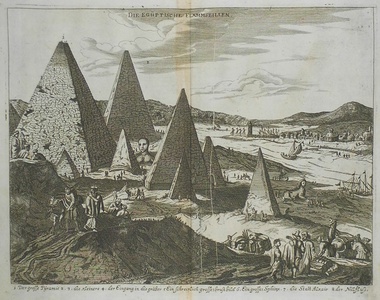| Method | Copper engraving |
| Artist | Johann Christoph Wagner |
| Published | [Augsburg: Jacob Koppmayer, c. 1684] |
| Dimensions | Image 248 x 326 mm, Plate 261 x 332 mm, Sheet 311 x 364 mm |
| Notes |
A view of the pyramids of Giza and the Nile from Johann Cristoph Wagner's Delineatio provinciarum Pannoniae et imperii Turcici in oriente, first published in 1684. Wagner's book gave a wide-ranging account of the topographical, historical and cultural differences in the Holy Roman and Ottoman Empires. Although a factual work, this particular image is somewhat fictional. The shape of the pyramids have certainly been altered. In fact their narrowness is a direct influence from the Pyramid of Cestius in Rome, built in 12BC. It was a far easier site for the European traveller and inspired many visiting artists who established its proportions as typical of pyramids elsewhere. Perhaps Wagner felt bound to this European artistic trope. The two sphinx-like statues are also imaginary. Both Dutch and Eastern figures can be seen in the landscape. A key in the lower margin names notable parts of the scene. Johann Christoph Wagner (fl. 1685) was a Nuremberg journalist and author who helped shape western understanding of the Islamic world. Wagner was born in Nuremberg in 1640 and became a calendar writer in the city. Here, he became increasingly interested in the correlation between the astrological movements and world events. In around 1680 he moved to Augsburg, writing his Delineatio provinciarum Pannoniae et imperii Turcici in oriente in 1683, the year of the defeat of the Ottomans. He later moved his topographical and political interests to the Orient, bringing out a number of works on individual eastern countries. Condition: Vertical centre fold, as issued. Staining to centre fold. Two vertical printer's creases. Foxing in margins. |
| Framing | unmounted |
| Price | £150.00 |
| Stock ID | 41921 |

